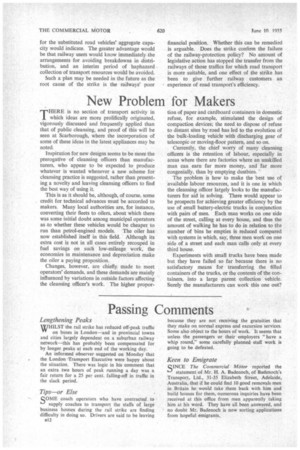New Problem for Makers
Page 46

If you've noticed an error in this article please click here to report it so we can fix it.
THERE is no section of transport activity in I which ideas are more prolifically originated, vigorously discussed and frequently applied than that of public cleansing, and proof of this will be seen at Scarborough, where the incorporation of some of these ideas in the latest appliances may be noted.
Inspiration for new designs seems to be more the prerogative of cleansing officers than manufacturers, who appear to be expected to produce whatever is wanted whenever a new scheme for cleansing practice is suggested, rather than presenting a novelty and leaving cleansing officers to find the best way of using it.
This is as it should be, although, of course, some credit for technical advances must be accorded to makers. Many local authorities are, for instance, converting their fleets to oilers, about which there was some initial doubt among municipal operators as-to whether these vehicles would be cheaper to run than petrol-engined models. The oiler has now established itself in this field. Although its extra cost is not in all cases entirely recouped in fuel savings on such low-mileage work, the economies in maintenance and depreciation make the oiler a paying proposition.
Changes, however, are chiefly made to meet operators' demands, and these demands are mainly influenced by variations in outside factors affecting the cleansing officer's work. The higher propor tion of paper and cardboard containers in domestic refuse, for example, stimulated the design of compaction devices; the need to dispose of refuse to distant sites by road has led to the evolution of the bulk-loading vehicle with discharging gear of telescopic or moving-floor pattern, and so on.
Currently, the chief worry of many cleansing officers is the retention of labour, especially in areas where there are factories where an unskilled man can earn far more money, and far more congenially, than by emptying dustbins.
The problem is how to make the best use of available labour resources, and it is one in which the cleansing officer largely looks to the manufacturers for aid in solving. There would appear to be prospects for achieving greater efficiency by the use of small battery-electric trucks in conjunction with pairs of men. Each man works on one side of the street, calling at every house, and thus the amount of walking he has to do in relation to the number of bins he empties is reduced compared with systems in which, say, three men work on one side of a street and each man calls only at every third house.
Experiments with small trucks have been made but they have failed so far because there is no satisfactory means for transferring the filled containers of the trucks, or the contents of the containers, into a large parent collection vehicle. Surely the manufacturers can work this one out?




























































































































































